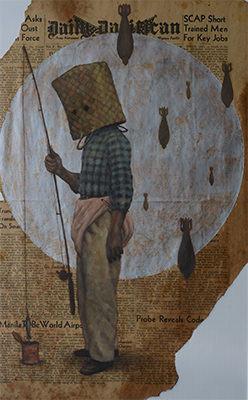Joven Mansit is a painter whose work is based on Philippine history. In his deceptively realistic painterly re-creations of old photographs and documents, he achieves a transformation of the “historical document.” The document is liberated from its indexical relation to past events, and becomes an imaginary scene which disrupts the present—inscribed into popular fictions, carrying latent memories, a fractured representation of a living mythology. In other words, Mansit blurs the line between representation and the waking dream—or even the hallucinations—of history. But not only does he meticulously re-paint historical images, thus fictionalizing and mythologizing them. Above all, he is a collagist and a manipulator of images, icons, signs, and symbols. In his compositions, he transforms what the images depict into scenographies of Filipino history that take the shape of a historical theatre of the absurd. It is in the realm of the surreal and the absurd that images open up to multiple associations—but where they lead us is nevertheless not left to chance. Rather, Mansit’s paintings transport us into a realm of dismembered icons, capturing contemporary myth and historical experience at once.
Among the works by Joven Mansit on display is a series of oil paintings using pages from the English-language Philippine newspaper Daily Pacificanas backdrops. The pages come from the 1940s and the headlines situate us in World War II. The scenes painted onto the newspaper depict figures covering their heads with the so-called “bayong,” a Filipino basket. This image is itself an “icon” of sorts, immediately recognizable as an image of traitors: the Makapili, or Alliance of Philippine Patriots. The Makapili was a militant group formed in the Philippines during WWII that gave military aid to imperial Japan. The Makapili are best remembered for aiding the Japanese by pointing out insurgents while covering their heads with the bayong in order to conceal their identity. The head and face is also a key motif that Mansit alters and manipulates in his other works. It is an image of the named and the nameless, of a playful engagement with both fundamentally uncertain and haunted identities.
Joven Mansit, born 1984 in the Philippines, lives and works in Manila

